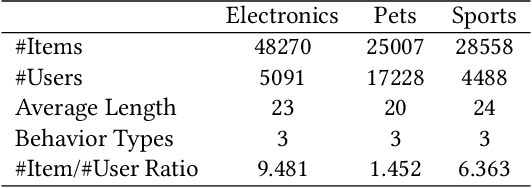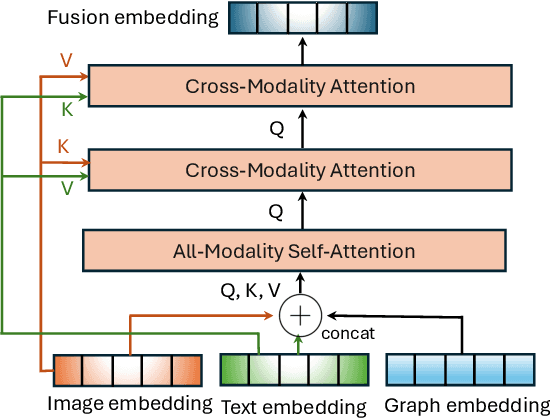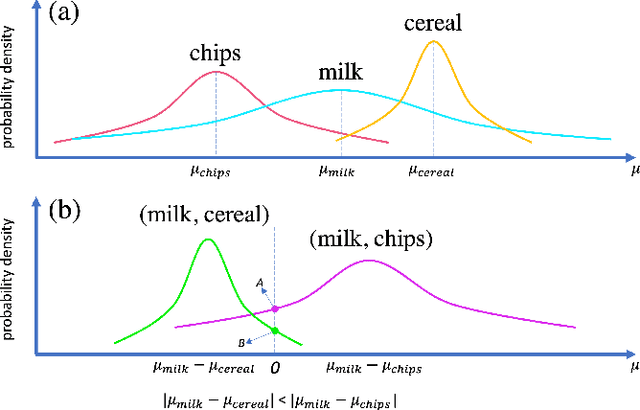Jianpeng Xu
Triple Modality Fusion: Aligning Visual, Textual, and Graph Data with Large Language Models for Multi-Behavior Recommendations
Oct 16, 2024



Abstract:Integrating diverse data modalities is crucial for enhancing the performance of personalized recommendation systems. Traditional models, which often rely on singular data sources, lack the depth needed to accurately capture the multifaceted nature of item features and user behaviors. This paper introduces a novel framework for multi-behavior recommendations, leveraging the fusion of triple-modality, which is visual, textual, and graph data through alignment with large language models (LLMs). By incorporating visual information, we capture contextual and aesthetic item characteristics; textual data provides insights into user interests and item features in detail; and graph data elucidates relationships within the item-behavior heterogeneous graphs. Our proposed model called Triple Modality Fusion (TMF) utilizes the power of LLMs to align and integrate these three modalities, achieving a comprehensive representation of user behaviors. The LLM models the user's interactions including behaviors and item features in natural languages. Initially, the LLM is warmed up using only natural language-based prompts. We then devise the modality fusion module based on cross-attention and self-attention mechanisms to integrate different modalities from other models into the same embedding space and incorporate them into an LLM. Extensive experiments demonstrate the effectiveness of our approach in improving recommendation accuracy. Further ablation studies validate the effectiveness of our model design and benefits of the TMF.
Prompt Optimizer of Text-to-Image Diffusion Models for Abstract Concept Understanding
Apr 17, 2024Abstract:The rapid evolution of text-to-image diffusion models has opened the door of generative AI, enabling the translation of textual descriptions into visually compelling images with remarkable quality. However, a persistent challenge within this domain is the optimization of prompts to effectively convey abstract concepts into concrete objects. For example, text encoders can hardly express "peace", while can easily illustrate olive branches and white doves. This paper introduces a novel approach named Prompt Optimizer for Abstract Concepts (POAC) specifically designed to enhance the performance of text-to-image diffusion models in interpreting and generating images from abstract concepts. We propose a Prompt Language Model (PLM), which is initialized from a pre-trained language model, and then fine-tuned with a curated dataset of abstract concept prompts. The dataset is created with GPT-4 to extend the abstract concept to a scene and concrete objects. Our framework employs a Reinforcement Learning (RL)-based optimization strategy, focusing on the alignment between the generated images by a stable diffusion model and optimized prompts. Through extensive experiments, we demonstrate that our proposed POAC significantly improves the accuracy and aesthetic quality of generated images, particularly in the description of abstract concepts and alignment with optimized prompts. We also present a comprehensive analysis of our model's performance across diffusion models under different settings, showcasing its versatility and effectiveness in enhancing abstract concept representation.
LLM-Ensemble: Optimal Large Language Model Ensemble Method for E-commerce Product Attribute Value Extraction
Feb 29, 2024


Abstract:Product attribute value extraction is a pivotal component in Natural Language Processing (NLP) and the contemporary e-commerce industry. The provision of precise product attribute values is fundamental in ensuring high-quality recommendations and enhancing customer satisfaction. The recently emerging Large Language Models (LLMs) have demonstrated state-of-the-art performance in numerous attribute extraction tasks, without the need for domain-specific training data. Nevertheless, varying strengths and weaknesses are exhibited by different LLMs due to the diversity in data, architectures, and hyperparameters. This variation makes them complementary to each other, with no single LLM dominating all others. Considering the diverse strengths and weaknesses of LLMs, it becomes necessary to develop an ensemble method that leverages their complementary potentials. In this paper, we propose a novel algorithm called LLM-ensemble to ensemble different LLMs' outputs for attribute value extraction. We iteratively learn the weights for different LLMs to aggregate the labels with weights to predict the final attribute value. Not only can our proposed method be proven theoretically optimal, but it also ensures efficient computation, fast convergence, and safe deployment. We have also conducted extensive experiments with various state-of-the-art LLMs, including Llama2-13B, Llama2-70B, PaLM-2, GPT-3.5, and GPT-4, on Walmart's internal data. Our offline metrics demonstrate that the LLM-ensemble method outperforms all the state-of-the-art single LLMs on Walmart's internal dataset. This method has been launched in several production models, leading to improved Gross Merchandise Volume (GMV), Click-Through Rate (CTR), Conversion Rate (CVR), and Add-to-Cart Rate (ATC).
LLMs with User-defined Prompts as Generic Data Operators for Reliable Data Processing
Dec 26, 2023Abstract:Data processing is one of the fundamental steps in machine learning pipelines to ensure data quality. Majority of the applications consider the user-defined function (UDF) design pattern for data processing in databases. Although the UDF design pattern introduces flexibility, reusability and scalability, the increasing demand on machine learning pipelines brings three new challenges to this design pattern -- not low-code, not dependency-free and not knowledge-aware. To address these challenges, we propose a new design pattern that large language models (LLMs) could work as a generic data operator (LLM-GDO) for reliable data cleansing, transformation and modeling with their human-compatible performance. In the LLM-GDO design pattern, user-defined prompts (UDPs) are used to represent the data processing logic rather than implementations with a specific programming language. LLMs can be centrally maintained so users don't have to manage the dependencies at the run-time. Fine-tuning LLMs with domain-specific data could enhance the performance on the domain-specific tasks which makes data processing knowledge-aware. We illustrate these advantages with examples in different data processing tasks. Furthermore, we summarize the challenges and opportunities introduced by LLMs to provide a complete view of this design pattern for more discussions.
LLM-TAKE: Theme Aware Keyword Extraction Using Large Language Models
Dec 01, 2023Abstract:Keyword extraction is one of the core tasks in natural language processing. Classic extraction models are notorious for having a short attention span which make it hard for them to conclude relational connections among the words and sentences that are far from each other. This, in turn, makes their usage prohibitive for generating keywords that are inferred from the context of the whole text. In this paper, we explore using Large Language Models (LLMs) in generating keywords for items that are inferred from the items textual metadata. Our modeling framework includes several stages to fine grain the results by avoiding outputting keywords that are non informative or sensitive and reduce hallucinations common in LLM. We call our LLM-based framework Theme-Aware Keyword Extraction (LLM TAKE). We propose two variations of framework for generating extractive and abstractive themes for products in an E commerce setting. We perform an extensive set of experiments on three real data sets and show that our modeling framework can enhance accuracy based and diversity based metrics when compared with benchmark models.
GNN-GMVO: Graph Neural Networks for Optimizing Gross Merchandise Value in Similar Item Recommendation
Oct 26, 2023Abstract:Similar item recommendation is a critical task in the e-Commerce industry, which helps customers explore similar and relevant alternatives based on their interested products. Despite the traditional machine learning models, Graph Neural Networks (GNNs), by design, can understand complex relations like similarity between products. However, in contrast to their wide usage in retrieval tasks and their focus on optimizing the relevance, the current GNN architectures are not tailored toward maximizing revenue-related objectives such as Gross Merchandise Value (GMV), which is one of the major business metrics for e-Commerce companies. In addition, defining accurate edge relations in GNNs is non-trivial in large-scale e-Commerce systems, due to the heterogeneity nature of the item-item relationships. This work aims to address these issues by designing a new GNN architecture called GNN-GMVO (Graph Neural Network - Gross Merchandise Value Optimizer). This model directly optimizes GMV while considering the complex relations between items. In addition, we propose a customized edge construction method to tailor the model toward similar item recommendation task and alleviate the noisy and complex item-item relations. In our comprehensive experiments on three real-world datasets, we show higher prediction performance and expected GMV for top ranked items recommended by our model when compared with selected state-of-the-art benchmark models.
Knowledge Graph Completion Models are Few-shot Learners: An Empirical Study of Relation Labeling in E-commerce with LLMs
May 17, 2023Abstract:Knowledge Graphs (KGs) play a crucial role in enhancing e-commerce system performance by providing structured information about entities and their relationships, such as complementary or substitutable relations between products or product types, which can be utilized in recommender systems. However, relation labeling in KGs remains a challenging task due to the dynamic nature of e-commerce domains and the associated cost of human labor. Recently, breakthroughs in Large Language Models (LLMs) have shown surprising results in numerous natural language processing tasks. In this paper, we conduct an empirical study of LLMs for relation labeling in e-commerce KGs, investigating their powerful learning capabilities in natural language and effectiveness in predicting relations between product types with limited labeled data. We evaluate various LLMs, including PaLM and GPT-3.5, on benchmark datasets, demonstrating their ability to achieve competitive performance compared to humans on relation labeling tasks using just 1 to 5 labeled examples per relation. Additionally, we experiment with different prompt engineering techniques to examine their impact on model performance. Our results show that LLMs significantly outperform existing KG completion models in relation labeling for e-commerce KGs and exhibit performance strong enough to replace human labeling.
NEAT: A Label Noise-resistant Complementary Item Recommender System with Trustworthy Evaluation
Feb 11, 2022



Abstract:The complementary item recommender system (CIRS) recommends the complementary items for a given query item. Existing CIRS models consider the item co-purchase signal as a proxy of the complementary relationship due to the lack of human-curated labels from the huge transaction records. These methods represent items in a complementary embedding space and model the complementary relationship as a point estimation of the similarity between items vectors. However, co-purchased items are not necessarily complementary to each other. For example, customers may frequently purchase bananas and bottled water within the same transaction, but these two items are not complementary. Hence, using co-purchase signals directly as labels will aggravate the model performance. On the other hand, the model evaluation will not be trustworthy if the labels for evaluation are not reflecting the true complementary relatedness. To address the above challenges from noisy labeling of the copurchase data, we model the co-purchases of two items as a Gaussian distribution, where the mean denotes the co-purchases from the complementary relatedness, and covariance denotes the co-purchases from the noise. To do so, we represent each item as a Gaussian embedding and parameterize the Gaussian distribution of co-purchases by the means and covariances from item Gaussian embedding. To reduce the impact of the noisy labels during evaluation, we propose an independence test-based method to generate a trustworthy label set with certain confidence. Our extensive experiments on both the publicly available dataset and the large-scale real-world dataset justify the effectiveness of our proposed model in complementary item recommendations compared with the state-of-the-art models.
GAN-based Recommendation with Positive-Unlabeled Sampling
Dec 12, 2020



Abstract:Recommender systems are popular tools for information retrieval tasks on a large variety of web applications and personalized products. In this work, we propose a Generative Adversarial Network based recommendation framework using a positive-unlabeled sampling strategy. Specifically, we utilize the generator to learn the continuous distribution of user-item tuples and design the discriminator to be a binary classifier that outputs the relevance score between each user and each item. Meanwhile, positive-unlabeled sampling is applied in the learning procedure of the discriminator. Theoretical bounds regarding positive-unlabeled sampling and optimalities of convergence for the discriminators and the generators are provided. We show the effectiveness and efficiency of our framework on three publicly accessible data sets with eight ranking-based evaluation metrics in comparison with thirteen popular baselines.
 Add to Chrome
Add to Chrome Add to Firefox
Add to Firefox Add to Edge
Add to Edge